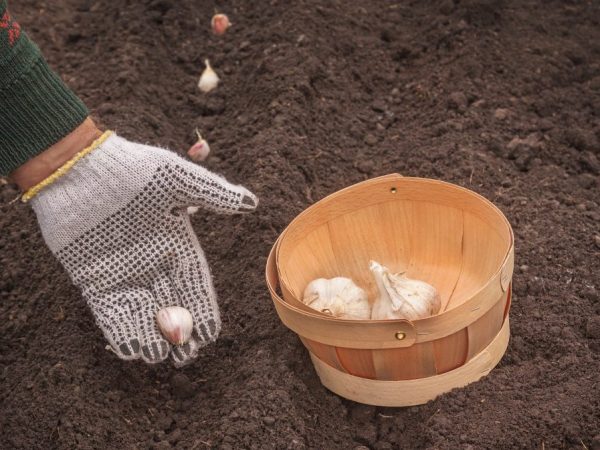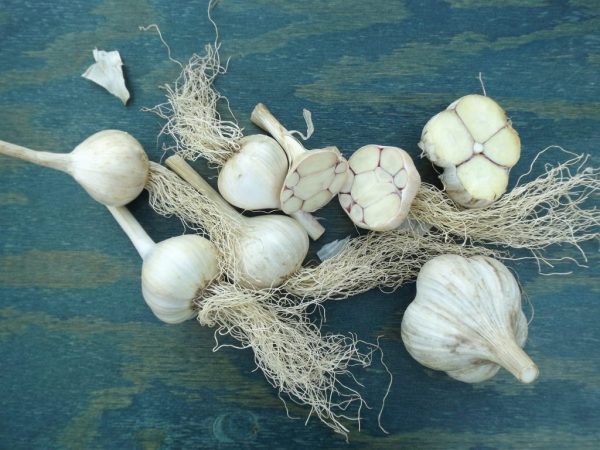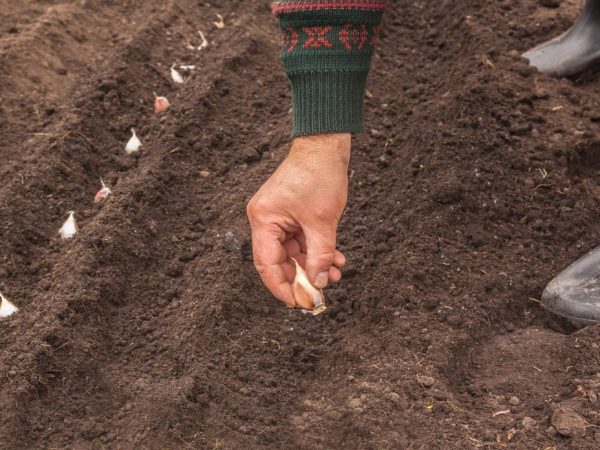Rules for planting garlic before winter in Belarus
Garlic is planted in Belarus for the winter. This culture is very popular among many peoples of the world and is used not only in cooking, but also in medicine. Avicenna also claimed that it helps with many diseases. During the construction of the Egyptian pyramids, slaves were introduced to the diet of this culture as a preventive measure. The article will discuss how to properly plant garlic for the winter in Belarus.

Rules for planting garlic before winter in Belarus
Boarding time
Planting of garlic before winter in Belarus is carried out in the fall. The site is prepared in advance, it should be cleared of previous crops in the middle of summer. Planting is carried out in October, best of all in the first half of it, because the plant planted in November does not have time to take root. If a crop is planted early in the fall, for example, at the beginning of September, then it will have time to germinate, and frost can cause irreparable harm to it. The garlic planted in October has time to take root and yield high yields.
The lunar calendar will help to determine the most favorable period for planting garlic in 2018. It indicates the sowing time of various crops, depending on the territory.
For example, planting garlic for the winter of 2017 in Belarus was recommended according to the lunar calendar in October, namely on the 5th, 6th, 20th, 22nd. It will be harvested in August 2018. If the culture will be grown from bulbs, then it should be planted in April. When to plant garlic for the winter in Belarus - the answer to this question will be given by the lunar calendar. The culture planted these days gives good germination and a high yield.
Cultivars
Planting garlic for the winter in Belarus largely depends on the variety. Gardeners need to choose one that is ideal for local growing conditions. The types of culture that form the arrows are distinguished by good endurance and are not afraid of frosty winters.
The characteristics of some varieties will allow gardeners to choose the one suitable for the conditions:
- Lyubasha - the variety belongs to breeders from Ukraine, tolerates winter and drought well. It is stored well, while it does not lose its taste. The plant reaches a height of 120 cm, the bulb consists of 5-7 cloves, its average weight is 80 g. The color of the bulb is white with purple threads.
- Ukrainian white - does not form an arrow, but it lends itself well to storage. Its bulbs are large, weighing 150 g, they consist of 5-12 cloves.
- Spas - also belongs to the Ukrainian selection, gives good yields and is distinguished by excellent keeping quality. The average weight of the bulbs is 80 g.
- Jubilee Gribovsky - the variety was bred for a long time, but this does not prevent it from being a leader among other varieties. It gained immense popularity thanks to its high yield, resistance to most pests and disease states. His bulb is small, about 40 g.
- Reliable - a semi-sharp variety, stored for up to a year, which is why its name came about. The onion consists of 5-7 cloves.
- Jubilee 07 - keeps well and gives high yields, semi-sharp taste.
- Rocambol is a semi-hot variety, its taste resembles that of onions.
All of the listed crop varieties are suitable for growing in Belarus. Which one to give preference to, it is necessary to decide the gardeners. After all, each culture is distinguished by its taste, and this is an individual choice.
Seed preparation

Long growing time
Winter garlic, unlike spring garlic, can be propagated by both chives and seeds. But it will take as long as 2 years to grow a full-fledged culture from seeds, and you can grow a culture from cloves in just a year. Seeds are used mainly when there is not enough planting material.
Before planting garlic for the winter in Belarus, the material is carefully selected:
- choose large and intact teeth;
- reject small and rotten teeth, planting material with a broken shell.
A suitable material is disinfected in an ash solution (2 glasses of ash are boiled for 30 minutes in 2 liters of water, cooled). Disinfection can be carried out using a salt solution (3 tablespoons per 5 liters of water) for 2 minutes. After that, the teeth are dipped for one minute in a solution of copper sulfate (1 teaspoon per 10 liters of water).
Plot
The culture is light-loving, so you should choose a sunny area on non-acidic soil, best of all sandy loam. Two weeks before planting, the soil will be fertilized with humus (5-6 kg), superphosphate and potassium fertilizers are applied. The amount of fertilizer applied depends on the fertility of the soil: the more fertile it is, the less fertilizer must be applied per m². It is recommended to cover the area with foil prior to planting.
Favorable predecessors
When determining a site for a crop, you need to know which plants are its favorable predecessors, and after which it will not give a good harvest. The scientist established that the universal predecessors of the plant are annual crops of a short growing season:
- squash;
- tomatoes;
- rye, oats;
- different types of berries.
You should not plant the plant after the plants that are harvested in September-October, as the soil will not have time to rest. It is forbidden to plant a crop in the very place where it grew in the previous year. This garlic patch is only used after a few days.
Landing

We sit down at a short distance
The teeth are planted in prepared grooves, the distance between the teeth is 10-15 cm, between the rows - 25-30 cm, the depth of the grooves is no more than 20 cm. Sand is poured onto their bottom, and the teeth are planted in it. It does not allow the planting material to contact the ground and protects the teeth from decay. The distance between the planting material depends on its size: the larger the cloves, the greater the distance and vice versa.
The grooves are covered with earth, the bed is covered with mulch (peat, sawdust or straw). Before snow falls, the area is covered with roofing material or foil to protect it from frost. The snow covering the bed reliably protects it from the cold, as it serves as a kind of blanket.
If sowing is carried out with seeds, then the depth of the furrows should not exceed 3 cm, the distance between the grooves - no more than 10 cm, between the planting material - no more than 2 cm.The bulbs planted in April will turn into small bulbs with one clove until autumn, which must be collected, dry and plant again on the site in order to collect a full harvest of garlic in a year.
Care after landing
The culture after planting does not require much trouble, it is characterized by increased resistance to cold. A plant planted in time for the cold grows roots and perfectly tolerates the winter cold, if the bed is well mulched or covered with roofing material.
In the spring, the shelter is removed so that it does not interfere with the sprouts to break through the soil. In June, arrows appear on the culture, they are broken out, not allowing them to reach 10 cm, as they take away strength, and the bulb will grow small.
Fertilizer
After the emergence of sprouts, nitrogen and organic fertilizers (urea, mullein or bird droppings) are applied to the soil.In June or early July, plants are fertilized with an ash solution (a glass of ash is dissolved in 10 liters of water).
Organic fertilizers are the best option for this crop. They allow her to grow a large bulb.
Watering
The plant requires constant watering, especially in the spring during the period of active growth. During the ripening period of the bulbs, moderate watering is sufficient. If the weather is rainy, then there is no need to water the sprouts. Waterlogging of the soil to the depth of winter garlic can lead to rotting of the bulbs and the spread of various painful conditions.
After watering, the soil is loosened and weeds are removed. If, after the emergence of seedlings, the bed was mulched, then caring for the plant will be much easier.
Harvesting
The best days for harvesting are sunny. The optimal time for harvesting crops falls at the end of July - beginning of August. The lower leaves will turn yellow before this time. The selected crop is dried in the sun for a week. The bulbs are cleaned of the ground, the stems are cut and wreaths are woven. The finished wreaths are stored in a cool, well-ventilated place in winter.
Overripening of culture in the ground is not allowed. In this case, the teeth begin to sprout, the bulbs after harvesting disintegrate, lose their presentation and are poorly preserved.
Conclusion
Almost all gardeners are engaged in the cultivation of garlic in Belarus. A festive table cannot be imagined without it. Growing a winter plant is practically no different from the methods of planting it in other countries. Only the timing of planting and harvesting differs. The main task of gardeners when growing this crop is to prevent the bulbs from freezing out in the winter with little snow. Here it is necessary to be guided by the amount of snow: if it is enough, then it is better to cover the site not to cover it. Strong shoots in the spring are a testament to the culture that has survived the winter well.


